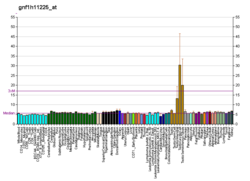Protein-coding gene in the species Homo sapiens
| OR13C5 |
|---|
|
| Identifiers |
|---|
| Aliases | OR13C5, OR9-11, olfactory receptor family 13 subfamily C member 5 |
|---|
| External IDs | HomoloGene: 88423; GeneCards: OR13C5; OMA:OR13C5 - orthologs |
|---|
| Gene location (Human) |
|---|
 | | Chr. | Chromosome 9 (human)[1] |
|---|
| | Band | 9q31.1 | Start | 104,598,457 bp[1] |
|---|
| End | 104,599,413 bp[1] |
|---|
|
| RNA expression pattern |
|---|
| Bgee | | Human | Mouse (ortholog) |
|---|
| Top expressed in | - testicle
- ventricular zone
- primary visual cortex
- pituitary gland
- anterior pituitary
- prefrontal cortex
- C1 segment
- hypothalamus
- caudate nucleus
- myometrium
|
| | | More reference expression data |
|
|---|
| BioGPS | 
 | | More reference expression data |
|
|---|
|
| Gene ontology |
|---|
| Molecular function | - G protein-coupled receptor activity
- signal transducer activity
- olfactory receptor activity
| | Cellular component | - membrane
- plasma membrane
- integral component of membrane
| | Biological process | - sensory perception of smell
- signal transduction
- response to stimulus
- detection of chemical stimulus involved in sensory perception of smell
- G protein-coupled receptor signaling pathway
| | Sources:Amigo / QuickGO |
|
| Orthologs |
|---|
| Species | Human | Mouse |
|---|
| Entrez | | |
|---|
| Ensembl | | |
|---|
| UniProt | | |
|---|
| RefSeq (mRNA) | | |
|---|
| RefSeq (protein) | | |
|---|
| Location (UCSC) | Chr 9: 104.6 – 104.6 Mb | n/a |
|---|
| PubMed search | [2] | n/a |
|---|
|
| Wikidata |
|
Olfactory receptor 13C5 is a protein that in humans is encoded by the OR13C5 gene.[3]
Olfactory receptors interact with odorant molecules in the nose, to initiate a neuronal response that triggers the perception of a smell. The olfactory receptor proteins are members of a large family of G-protein-coupled receptors (GPCR) arising from single coding-exon genes. Olfactory receptors share a 7-transmembrane domain structure with many neurotransmitter and hormone receptors and are responsible for the recognition and G protein-mediated transduction of odorant signals. The olfactory receptor gene family is the largest in the genome. The nomenclature assigned to the olfactory receptor genes and proteins for this organism is independent of other organisms.[3]
See also
References
- ^ a b c GRCh38: Ensembl release 89: ENSG00000277556 – Ensembl, May 2017
- ^ "Human PubMed Reference:". National Center for Biotechnology Information, U.S. National Library of Medicine.
- ^ a b "Entrez Gene: OR13C5 olfactory receptor, family 13, subfamily C, member 5".
Further reading
- Hoppe R, Breer H, Strotmann J (2004). "Organization and evolutionary relatedness of OR37 olfactory receptor genes in mouse and human". Genomics. 82 (3): 355–64. doi:10.1016/S0888-7543(03)00116-2. PMID 12906860.
- Malnic B, Godfrey PA, Buck LB (2004). "The human olfactory receptor gene family". Proc. Natl. Acad. Sci. U.S.A. 101 (8): 2584–9. Bibcode:2004PNAS..101.2584M. doi:10.1073/pnas.0307882100. PMC 356993. PMID 14983052.
- Humphray SJ, Oliver K, Hunt AR, et al. (2004). "DNA sequence and analysis of human chromosome 9". Nature. 429 (6990): 369–74. Bibcode:2004Natur.429..369H. doi:10.1038/nature02465. PMC 2734081. PMID 15164053.
External links
This article incorporates text from the United States National Library of Medicine, which is in the public domain.
Class I
(fish-like receptors) | | Family 51 | |
|---|
| Family 52 | |
|---|
| Family 56 | |
|---|
|
|---|
Class II
(tetrapod specific receptors) | | Family 1 | |
|---|
| Family 2 | |
|---|
| Family 3 | |
|---|
| Family 4 | |
|---|
| Family 5 | |
|---|
| Family 6 | |
|---|
| Family 7 | |
|---|
| Family 8 | |
|---|
| Family 9 | |
|---|
| Family 10 | |
|---|
| Family 11 | |
|---|
| Family 12 | |
|---|
| Family 13 | |
|---|
|
|---|

















